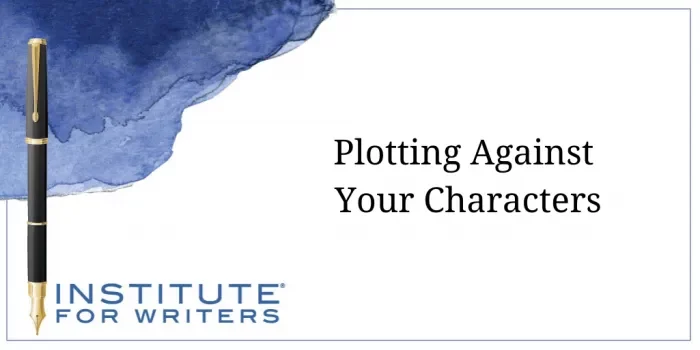1000 N. West Street #1200, Wilmington, DE 19801
© 2024 Direct Learning Systems, Inc. All rights reserved.

What’s the worst thing I can do to this character?
The first time I ran across that question was in an essay by award-winning science fiction and fantasy author Lois McMaster Bujold. My eyes stopped. This formulation was sheer genius and, at the same time, insanely obvious. I’d been sharing something similar with my Institute for Writers students on the importance of matching the external conflicts in a story to a character’s internal struggles for years, but there’s a deep and painful twist of the knife to coming up with the worst thing to do to a specific character. Naturally, this doesn’t mean that a serial killer should massacre your protagonist’s family and friends. Instead, it’s knowing how to challenge your characters’ weaknesses and twist their perceived strengths in a gut-wrenching way that will help them to grow.

I saw variations of Bujold’s question appear in other places as the years passed. It could have been borrowed and stripped of the attribution, or other writers could have come to the same question independently. (Did I mention that it was insanely obvious?) The most recent spot was on Robin LaFevers’ Instagram feed from October, 2019. She had just turned in Igniting Darkness, her fifth book featuring assassin nuns in medieval France, when she decided to share some of her prewriting exercises for those about to embark on NaNoWriMo. In that post, she discussed the importance of exploring your characters’ wants, needs, and wounds.
Wounds? That formulation might be new to you, but I’d read Ms. LaFevers blog post entitled “Mining Our Character’s Wounds” when it originally appeared in Writer Unboxed a few years ago. It’s become part of my writer’s toolbox. She made it clear that “wounds aren’t simply an attribute to be filled in on a worksheet. They are the rocket fuel for our character’s backstory, the backstory that drives their motivation and colors their world.”
While people will often separate plot and characterization for purposes of discussion, they are inextricably linked in the story itself. Plots are about what comes next, but protagonists will make choices about that upcoming action based on preconceptions, preoccupations, and personal experiences as well as the previously mentioned wants, needs, and wounds.
The relationship between plot and character isn’t additive. You can have the most devilishly intricate plot possible, but no one will be interested if it’s not populated by compelling characters. You can have the most engaging character imaginable, but it will be nothing more than a character sketch if nothing happens. Zero multiplied by anything equals zero. But when plot and character really come together in an amazing way, the effect isn’t just multiplicative. It can be downright logarithmic.
Here are a few things to keep in mind as you start plotting against your characters.
• Don’t go easy on your characters. While you might have intellectually internalized the importance of figuring out the worst thing that you can do to them, you may find yourself smoothing things over or stopping fights before they get started. After all, you’ve become attached to your characters and identify with them on some deep level.
• Don’t treat them like marionettes. If, on the other hand, you find yourself chortling happily while putting your characters through the worst moments in their lives, you shouldn’t take a step back from the story. You should lean into their perceptions instead. Feel what your character is feeling. If you can’t move yourself to tears, how can you expect to trigger an emotional response with your reader? (Go ahead and celebrate a well-written scene later.)
• Don’t try to force characters into predetermined plot outcomes. Detailed outlines are a good thing for many writers. They provide a road map. But sometimes our characters outgrow them. I remember trying to set-up a turning point in the relationship between my protagonist and her antagonist in Defending Irene, my middle grade novel about an American girl playing on an Italian boys’ soccer team. Since boneheaded stubbornness is my superpower, I went down to my desk day after day only to finish my writing time without making any progress. As soon as I realized that Irene was never going to win over Matteo no matter what she did, the dam broke and the rest of the story came flooding out.
• Don’t forget to give your characters a certain consistency even as they grow and change. Characters have to change in some vital way between the first word and the last because stories are all about transformation. They have accomplished tasks, overcome obstacles, and achieved goals. Not only that, the things that they’ve gone through have also given them fresh wounds. But there are some aspects of their characters that will hold firm even as they take surprising steps.
Kristin Wolden Nitz has had sixteen different addresses in eight different states since graduating from college. When she tells friends and family that she’s not moving again, they laugh. Kristin splits her time between writing novels and serving as one of our instructors. Kirkus described her novel Suspect as “intriguing, suspenseful fun.”
1000 N. West Street #1200, Wilmington, DE 19801
© 2024 Direct Learning Systems, Inc. All rights reserved.
1000 N. West Street #1200, Wilmington, DE 19801
© 2024 Direct Learning Systems, Inc. All rights reserved.
1000 N. West Street #1200, Wilmington, DE 19801
© 2024 Direct Learning Systems, Inc. All rights reserved.
2 Comments